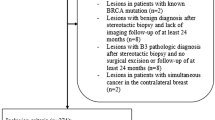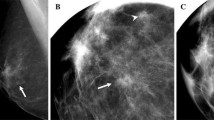Abstract
Objectives
We determined the failure rate of stereotactic core needle biopsy (SCNB) and its causes and final outcome in women recalled for calcifications at screening mammography.
Methods
We included a consecutive series of 624,039 screens obtained in a Dutch screening region between January 2009 and July 2019. Radiology reports and pathology results were obtained of all recalled women during 2-year follow-up.
Results
A total of 3495 women (19.6% of 17,809 recalls) were recalled for suspicious calcifications. SCNB was indicated in 2818 women, of whom 12 had incomplete follow-up and another 12 women refused biopsy. DCIS or invasive cancer was diagnosed in 880 of the remaining 2794 women (31.5%). SCNB failed in 62 women (2.2%, 36/2794). These failures were mainly due to a too posterior (n = 30) or too superficial location (n = 17) of the calcifications or calcifications too faint for biopsy (n = 13). Of these 62 women, 10 underwent surgical biopsy, yielding one DCIS (intermediate grade) and two invasive cancers (one intermediate grade and one high grade) and another two women were diagnosed with DCIS (both high grade) at follow-up. Thus, the malignancy rate after SCNB failure was 8.1% (5/62). Calcifications were depicted neither at SCNB specimen radiography nor at pathology in 16 women after (repeated) SCNB (0.6%, 31/2732). None of them proved to have breast cancer at 2-year follow-up.
Conclusions
The failure rate of SCNB for suspicious calcifications is low but close surveillance is warranted, as breast cancer may be present in up to 8% of these women.
Key Points
• The failure rate of stereotactic core needle biopsy (SCNB) for calcifications recalled at screening mammography was 2.2%.
• Failures were mainly due to calcifications that could not be reached by SCNB or calcifications too faint for biopsy.
• The management after failed SCNB was various. At least, close surveillance with a low threshold for surgical biopsy is recommended as breast cancer may be present in up to 8% of women with SCNB failure.




Similar content being viewed by others
Abbreviations
- BI-RADS:
-
Breast Imaging and Reporting System
- CCMO:
-
Central Committee on Research involving Human Subjects
- DCIS:
-
Ductal carcinoma in situ
- MRI:
-
Magnetic resonance imaging
- SCNB:
-
Stereotactic core needle biopsy
References
Dibden A, Offman J, Duffy SW, Gabe R (2020) Worldwide Review and meta-analysis of cohort studies measuring the effect of mammography screening programmes on incidence-based breast cancer mortality. Cancers 12:976. https://doi.org/10.3390/cancers12040976
Sankatsing VDV, van Ravesteyn NT, Heijnsdijk EAM et al (2017) The effect of population-based mammography screening in Dutch municipalities on breast cancer mortality: 20 years of follow-up. Int J Cancer 141:671–677
Tabar L, Dean PB, Chen TH et al (2019) The incidence of fatal breast cancer measures the increased effectiveness of therapy in women participating in mammography screening. Cancer 125:515–523
Luiten JD, Voogd AC, Luiten EJT et al (2020) Recall and outcome of screen-detected microcalcifications during two decades of mammography screening in the Netherlands National Breast Screening Program. Radiology 294:528–537
Fischer U, Baum F, Obenauer S et al (2002) Comparative study in patients with microcalcificatons: full-field digital mammography vs screen-film mammography. Eur Radiol 12:2679–2683
Weber RJP, Nederend J, Voogd AC, Strobbe LJ, Duijm LEM (2015) Screening outcome and surgical treatment during and after the transition from screen-film to digital screening mammography in the south of the Netherlands. Int J Cancer 137:135–143
Jackman RJ, Marzoni FA Jr (2003) Stereotactic histologic biopsy with patients prone: technical feasibility in 98% of mammographically detected lesions. AJR Am J Rontgenol 180:785–794
Yu YH, Liang C, Yuan XZ (2010) Diagnostic value of vacuum-assisted breast biopsy for breast carcinoma: a meta-analysis and systematic review. Breast Cancer Res Treat 120:469–479
American College of Radiology (2003) Breast Imaging Reporting and Data System (BIRADS), 4th edn. American College of Radiology, Reston
American College of Radiology. BI-RADS Committee (2013) ACR BI-RADS atlas : breast imaging reporting and data system, 5th edn. American College of Radiology, Reston
Brennan SB, D’Alessio D, Liberman L, Giri D, Brogi E, Morris EA (2014) Cancelled stereotactic biopsy of calcifications not seen using the stereotactic technique: do we still need to biopsy? Eur Radiol 24:907–912
Del Turco MR, Mantellini P, Ciatto S et al (2007) Full-field digital versus screen-film mammography: comparative accuracy in concurrent screening cohorts. AJR Am J Roentgenol 189:860–866
Bahl M, Maunglay M, D’Alessandro HA, Lehman CD (2019) Comparison of upright digital breast tomosynthesis-guided versus prone stereotactic vacuum-assisted breast biopsy. Radiology 290:298–304
Kuhl CK, Schrading S, Bieling HB et al (2007) MRI for diagnosis of pure ductal carcinoma in situ: a prospective observational study. Lancet 370:485–492
Jeffries DO, Neal CH, Noroozian M et al (2015) Surgical biopsy is still necessary for BI-RADS 4 calcifications found on digital mammography that are technically too faint for stereotactic core biopsy. Breast Cancer Res Treat 154:557–561
Lomoschitz FM, Helbich TH, Rudas M et al (2004) Stereotactic 11-gauge vacuum-assisted breast biopsy: influence of number of specimens on diagnostic accuracy. Radiology 232:897–903
Liberman L, Smolkin JH, Dershaw DD, Morris EA, Abramson AF, Rosen PP (1998) Calcification retrieval at stereotactic, 11-gauge, directional, vacuum-assisted breast biopsy. Radiology 208:251–260
Jackman RJ, Rodriguez-Soto J (2006) Breast microcalcifications: retrieval failure at prone stereotactic core and vacuum breast biopsy – frequency, causes, and outcome. Radiology 239:61–70
Margolin FR, Kaufman L, Jacobs RP, Denny SR, Schrumpf JD (2004) Stereotactic core breast biopsy of malignant calcifications: diagnostic yield of cores with and cores without calcifications on specimen radiographs. Radiology 233:251–254
Funding
The authors state that this work has not received any funding.
Author information
Authors and Affiliations
Corresponding author
Ethics declarations
Guarantor
The scientific guarantor of this publication is Lucien EM Duijm, MD, PhD.
Conflict of interest
Lucien EM Duijm is Associated Editor for the “Breast section” of European Radiology. He has not taken part in the review or selection process of this article. The authors do not opt for preprint-sharing.
Statistics and biometry
One of the authors has significant statistical expertise.
No complex statistical methods were necessary for this paper.
Informed consent
Prior to participation, women gave informed consent that their data may be used for quality assurance of the screening program and for scientific purposes. An opt-out construction enables the women to refrain from this consent. Only three recalled women used this opt-out and they were excluded from analysis.
Ethical approval
Ethical approval was not required for the current study, according to the Dutch Central Committee on Research involving Human Subjects (CCMO).
Methodology
• prospective
• observational
• multicenter study
Additional information
Publisher’s note
Springer Nature remains neutral with regard to jurisdictional claims in published maps and institutional affiliations.
Rights and permissions
About this article
Cite this article
Duijm, L.E.M., Strobbe, L.J.A., van Breest Smallenburg, V. et al. Failure of stereotactic core needle biopsy in women recalled for suspicious calcifications at screening mammography: frequency, causes, and final outcome in a multi-institutional, observational follow-up study. Eur Radiol 32, 7420–7429 (2022). https://doi.org/10.1007/s00330-022-08806-3
Received:
Revised:
Accepted:
Published:
Issue Date:
DOI: https://doi.org/10.1007/s00330-022-08806-3




